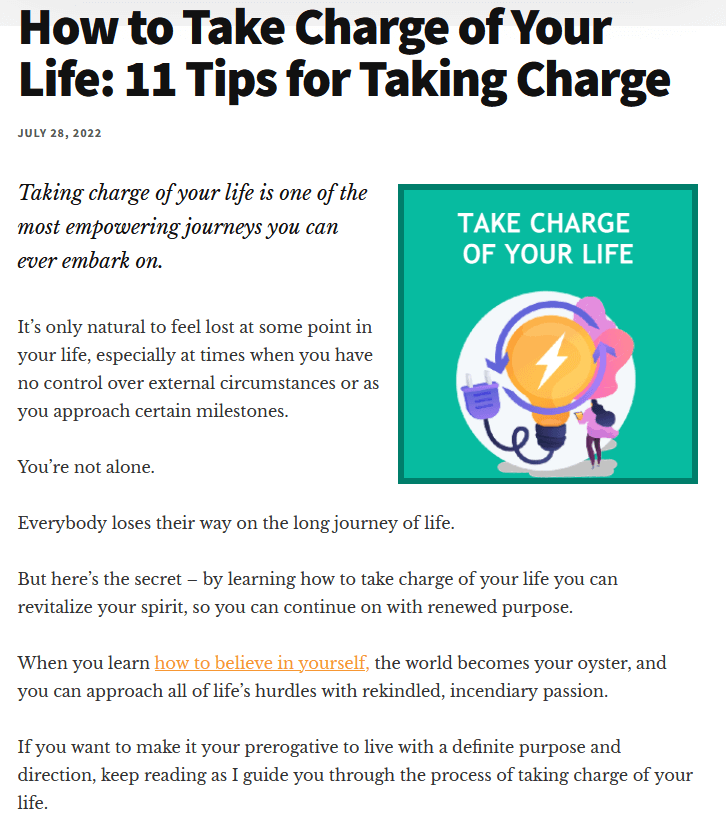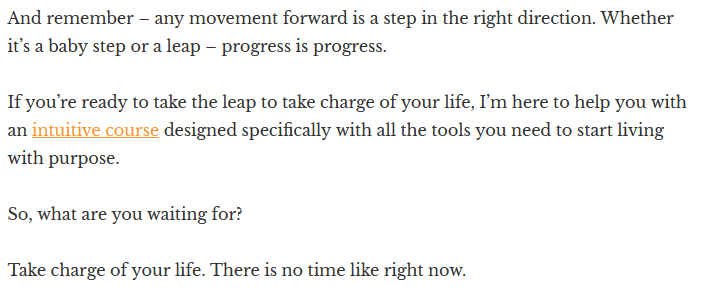If you’re reading this, I’m guessing you plugged some keywords into Google, scanned through a few URLs, and ultimately clicked on the one that led you to this page.
In this case, my plan worked perfectly.
See, I’ve crafted this article not only to read well but also to rank in Google’s Search Engine Results Pages (SERPs for short), where it’s more likely to find your eyeballs.
For these words to show up on your screen, I need to write them with search engine optimization (SEO) copywriting in mind – that is, optimizing my content so that the search engine gods promote it.
This is a fine line to walk.
- While I want to write copy that’s interesting and engaging, I also need it to be structured so that it finds its way onto the SERPs.
- And while I want search engines to pick it up, I don’t want to gut it of all character just for the purposes of SEO and bore the reader to death in the process.
But there’s a sweet spot where these two ideas coexist harmoniously – where SEO fundamentals and copywriting principles live in tandem.
Below I’ll show you how you can blend these concepts to create content that’s optimized for SEO and persuasive enough to achieve conversions.
Get more leads with less effort.
If you want a steady flow of targeted leads, we’ve got a proven process for driving organic traffic and converting it into qualified leads.
Why Good Copywriting Is Essential for SEO
It’s no secret that SEO is a fantastic strategy for driving organic traffic to your website. But it’s not enough on its own – it needs good, solid, persuasive content to send potential leads down your funnel.
But although you might enjoy the works of Jules Vern, Virginia Woolf, Tom Clancy, or any other number of popular authors, those writing styles don’t lend themselves to creating engaging copy.
Good copy needs to be concise, valuable, and entertaining — with a recognizable brand voice. It’s too-the-point rather than flowery, and every word needs to serve a purpose.
When used with SEO, good copywriting will help you achieve several things:
- Better Click-Through Rates (CTRs). With well-crafted headlines and meta descriptions, you’ll pique the interest of browsing readers. This means people are likelier to click on your content and visit your website.
- Increased Engagement. Good copywriting helps to keep your readers engaged with your content. When your content is interesting and engaging, people are more likely to stay on your website longer, which can improve your standing in search engine rankings.
- Higher Conversions. The ultimate goal of SEO is to drive conversions. Good copywriting helps persuade people to make a purchase, subscribe to a newsletter, fill out a contact form, or whatever action you’d like them to take.
Blending SEO Fundamentals With Copywriting Principles: 6 Effective Methods
We know that you need both excellent copywriting and sound SEO principles to get people to your website – but how do you implement that practically?
Let’s take a look at a number of ways to blend SEO fundamentals with copywriting principles in the pursuit of great content:
1. Keep Keywords at the Forefront
Keywords are the seemingly magical items every SEO specialist on the internet is fighting over – and for good reason. They’re the words and phrases that users are entering into search engines to find your content.
It’s how you ended up here.
Before you start writing any content, it’s crucial to research and identify the keywords and phrases that people are using to search for information related to your product or service.
That being said, don’t let me give you the impression that keywords are the only thing you need to consider.
Search engines favor valuable content, and will actually penalize you if you repeat the same keywords so often that it sounds unnatural. So while keywords are important, you need to insert them in your content in a way that feels natural and organic.
Our SEO team spends a considerable amount of time researching keywords we have a chance ranking for, secondary keywords to target, as well as the keywords our competitors have been targeting.
Ultimately, this provides us with the blueprint for creating and guiding content.
Once we’ve performed solid keyword research and have an outline, we can then incorporate them naturally into our content.

This is the outline from keyword research we put together for a client.
Here you can see we’ve identified the main keyword we want to target – “take charge of your life” – some secondary keywords we’ll try to target, and the top competitors ranking for the same ones.
2. Craft Compelling Headlines
Your headline is everything – at least when it comes to grabbing the attention of someone scrolling through the SERPs.
It’s the first thing a reader sees, and it’s important that it’s not the last.
For this reason, your headlines need to be sharp.
But it’s not only about the writing – for SEO purposes, your headline should also contain the main keyword you’re targeting. The closer the headline matches the search intent of the user, the more likely they are to click on it and (hopefully) read the rest of your article.
Let’s not forget about size. Because Google only displays headlines of up to 580 pixels, yours should fit within these parameters. To ensure that my headlines are always the right size, I use the Google SERP Snippet Optimization Tool.

Here’s the headline we decided on for the article based on the keyword research we performed. Notice how it fits into the SERP size restrictions (490 pixels) and includes the main keyword we decided to target.
3. Your Introduction Must Suck (Me In)
Once you’ve attracted a reader to click on your article with a killer headline, you have to hook them with a compelling intro to your article.
Your introduction needs to be interesting from the first sentence. It needs to draw the reader in and give them a reason to keep reading your article.
Once I write an introduction, it goes through an extensive editing process to ensure it hits hard enough to make a lasting impact. Intros should be memorable – they should stick.
Beyond that, your introduction should do a few things:
- State the problem the article will address
- Include the main keyword – ideally in the first sentence
- Include an internal link (this improves the visibility, usability, and credibility of your website)
- Offer a solution to the aforementioned problem that encourages the reader to finish the article

Look at the above introduction to the content we’ve been using as an example. After some cursory examination, you should see that this particular introduction hits on all four points I just listed.
- The problem – feeling lost – is clearly stated.
- The main keyword of this article – “take charge of your life” – is evident in the first sentence.
- There’s an internal link included in the sixth paragraph.
- And finally, the solution – finding purpose and direction – is promised at the end.
4. Give Me a Break With Subheadings
No one reads entire articles – especially 2000+ word monsters.
To make it easier for readers to scan your content, break it up with well-written subheadings – this is copywriting 101.
Not only does this keep your readers engaged, it’s also an opportunity to insert secondary keywords and further improve your search engine ratings.

Using the same article as an example, look at this section. The subheading immediately tells people scanning through the article what this section is about.
It also includes one of the secondary keywords – how to take control of your life and be happy – that we identified when we performed the keyword research.
Remember that keywords don’t always have to be used verbatim, although that is the ideal way to use them. Since they aren’t always natural-sounding terms, shoehorning them into your article for the purpose of having them there will feel clunky and unnatural.
As I mentioned earlier, search engines frown upon copy that doesn’t read well but is over-optimized for keywords, and writing this way could negatively affect your ranking.
5. Include Calls to Action (CTAs)
A call to action (CTA) is a statement or instruction encouraging the reader to take a specific action, usually placed at the end of an article.
A CTA encourages the reader to go further with the content, subscribe to a newsletter, sign up for a service, make a purchase, or perform any other desired action.
CTAs are essential to motivate readers to take action and convert them from passive viewers to active participants. You can craft them in different styles – persuasive, urgent, or informative – depending on your goals and audience.
CTAs should never be overlooked. An article without a CTA is like a map without a destination. It may show you the way, but it doesn’t tell you where to go.

This is the CTA I’ve used to illustrate the points of this article. It encourages the reader to sign up for a course to help them take charge of their life. It effectively closes the loop, ties in with the overarching message of the article, and motivates the reader to take action.
6. Don’t Forget About Meta-Data
By now, it should be apparent that using keywords in your content is a big deal – but it’s not the only one.
It’s important to optimize on-page elements too. This includes your title tags, meta descriptions, and headers.
These can be easily overlooked – and often are – but are a simple way of improving the readability of your content and an opportunity to slip in a keyword or two.

Here you can see that I’ve inserted the main keyword – take charge of your life – into the meta description. I’ve also included a concise description of the article and a CTA that encourages the reader to click on it.
Now when anyone sees this article in the SERPs, they’ll have a better idea of what they’re about to read.
And that is how you create content that hits the mark using SEO fundamentals and copywriting principles.
Great Content Requires SEO and Copywriting. We Do Both.
Content creation, when done well, has many moving parts.
Many involve strategic SEO, while others require mastery of the English language and the art of persuasion.
We handle both sides of the equation.
If increasing your ranking in Google’s SERPs sounds good, then read more about our SEO and Content Marketing Services.

